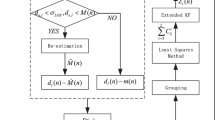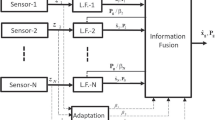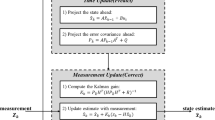Abstract
In this paper, a calibration method based on a two-step extended Kalman filter (EKF) is proposed. Firstly, the four vertex positions of a rectangle in the environment are calibrated. Specifically, in the first stage the initial position states of all anchor nodes are obtained using a rough localization method. In the second stage, the first and second step EKFs are used to obtain the real-time state of the measured target and all anchor nodes. The state estimation of all anchor nodes is achieved by employing the iterative process of the two-step EKF. The effectiveness and stability of the proposed algorithm are verified by simulations and experiment.










Similar content being viewed by others
References
Abdurlrahman, A., AbdulMalik, A., & Mansour, A. (2016). Ultra wideband indoor positioning technologies: analysis and recent advances. Sensors, 16(5), 1–36. May.
Chen, Z., Zhang, B., Stojanovic, V., Zhang,Y., & Zhang, Z., (2020). Event-based fuzzy control for TS fuzzy networked systems with various data missing. Neurocomputing, vol. 417, no. 322–332.
Cheng, P., Chen, M., Stojanovic,V., & He, S. (2021). Asynchronous fault detection filtering for piecewise homogenous Markov jump linear systems via a dual hidden Markov model. Mechanical Systems and Signal Processing, vol. 151, no. 107353.
Chintalapudi, K., Iyer, A. K., Padmanabhan, V., (2010). Indoor localization without the pain. Proceedings of the Annual International Conference on Mobile Computing and Networking, MOBICOM., pp. 173–184.
Crocco, M., Del Bue, A., & Murino, V. (2012). A bilinear approach to the position self-calibration of multiple sensors. IEEE Transactions on Signal Processing, 60(2), 660–673.
Fontana, R. J. (2004). Recent system applications of short-pulse ultra-wideband (UWB) technology. IEEE Transactions on Microwave Theory Technology, 52(9), 2087–2104. Sep.
Gezici, S., Zhi Tian, G.B., Giannakis, H., Kobayashi, A.F., Molisch, H.V., Poor & Sahinoglu, Z., (2005). Localization via ultra-wideband radios: a look at positioning aspects for future sensor networks. IEEE Signal Processing Magazine., vol. 22, no. 4, pp. 70–84.
Gezici, S., Tian, Z., Giannakis, G. B., & Kobayashi, H. (2005). Localization via ultra-wideband radios: a look at positioning aspects for future sensor networks. IEEE Signal Processing Magazine, 22(4), 70–84.
Guvenc, I., & Chong, C. (2009). A survey on TOA based wireless localization and NLOS mitigation techniques. IEEE Communications Surveys & Tutorials, 11(3), 107–124. Aug.
Hamer, M., & Andrea, R. (2018). Self-calibrating ultra-wideband network supporting multi-robot localization. IEEE Access, 6, 22292–22304.
Krapez, P., & Munih, M. (2020). Anchor calibration for real-time-measurement localization systems. IEEE Transactions on Instrumentation and Measurement.
Li, X., Cao, F., (2014). Location Based TOA Algorithm for UWB Wireless Body Area Networks. 2014 IEEE 12th International Conference on Dependable, Autonomic and Secure Computing, Dalian., pp. 507–511.
Liu, H., Darabi, H., Banerjee, P., & Liu, J., (2007). Survey of wireless indoor positioning techniques and systems. IEEE Trans. Syst., Man, Cybern., Part C, Appl. Rev., vol. 37, no. 6, pp. 1067–1080.
Liu, W., Ding, H., Huang, X., & Liu, Z., (2012). TOA estimation in IR UWB ranging with energy detection receiver using received signal characteristics. IEEE Communications Letters., vol. 16, no. 5, pp. 738–741.
Lo Piccolo, F., (2008). A new cooperative localization method for UMTS cellular networks. IEEE GLOBECOM 2008 - 2008 IEEE Global Telecommunications Conference, New Orleans, LO., pp. 1–5.
Luo, J., Zhang, Z., Liu, C., & Luo, H. (2018). Reliable and cooperative target tracking based on WSN and WiFi in indoor wireless networks. IEEE Access, 6, 24846–24855.
Stojanovic, V., He,S., & Zhang, B. (2020). Stojanovic V, He S, Zhang B. State and parameter joint estimation of linear stochastic systems in presence of faults and non-Gaussian noises. International Journal of Robust and Nonlinear Control, vol. 30, no. 16, pp. 6683–6700.
Stojanovic, V., & Prsic, D. (2020). Stojanovic V, Prsic D. Robust identification for fault detection in the presence of non-Gaussian noises: application to hydraulic servo drives. Nonlinear Dynamics, vol. 100, pp. 2299–2313.
Tao, H., Wang, P., Chen, Y., Stojanovic, V., & Yang, H. (2020). An unsupervised fault diagnosis method for rolling bearing using STFT and generative neural networks. Journal of the Franlin Institute, 357(11), 7286–7307.
Taponecco, L., Amico, A., & Mengali, U. (2011). Joint TOA and AOA estimation for UWB localization applications. IEEE Transactions on Wireless Communication, 10(7), 2207–2217. Jul.
Tarrio, P., Bernardos, A. M., & Casar, J. R. (2011). Weighted least squares techniques for improved received signal strength based localization. Sensors, 11(9), 8569–8592.
Tian, X., Wei, G., Wang, L., & Zhou, J. (2020). Wireless-sensor-network-based target localization: A semidefinite relaxation approach with adaptive threshold correction. Neurocomputing, 405, 229–238.
Wang, Y., Ma, S., & Chen, C. L. P. (2014). TOA-based passive localization in quasi-synchronous networks. IEEE Communications Letters, 18(4), 592–595.
Xu, C., He, J., Li, Y., Zhang, X., Zhou, X., & Duan, S. (2019). Optimal estimation and fundamental limits for target localization using IMU/TOA fusion method. IEEE Access, 7, 28124–28136.
Yin, J., Yang, Q., & Ni, L. (2008). Learning adaptive temporal radio maps for signal-strength-based location estimation. IEEE Transactions on Mobile Computing, 7(7), 869–883.
Yu, K., Wen, K., Li, Y., Zhang, S., & Zhang, K. (2019). A Novel NLOS mitigation algorithm for UWB localization in harsh indoor environments. IEEE Transactions on Vehicular Technology, 68(1), 686–699. Jan.
Zachariah, D., Angelis, A. D., Dwivedi, S., & Handel, P. (2013). Self-localization of asynchronous wireless nodes with parameter uncertainties. IEEE Signal Processing Letters, 20(6), 551–554.
Zhang, C., Kuhn, M., Merkl, B., Fathy, A., & Mahfouz, M. (2006). Accurate UWB indoor localization system utilizing time difference of arrival approach, in Proc (pp. 515–518). San Diego, CA, USA: IEEE Radio Wireless Symp.
Zhou, Y., Law, C. L., & Chin, F. (2010). Construction of local anchor map for indoor position measurement system. IEEE Transactions on Instrumentation and Measurement, 59(7), 1986–1988.
Author information
Authors and Affiliations
Corresponding author
Additional information
Publisher's Note
Springer Nature remains neutral with regard to jurisdictional claims in published maps and institutional affiliations.
This work was supported in part by the National Natural Science Foundation of China [grant number 61873169], the Program for Professor of Special Appointment (Eastern Scholar) at Shanghai Institutions of Higher Learning.
Rights and permissions
About this article
Cite this article
Tian, X., Wei, G. & Zhou, J. Calibration method of anchor position in indoor environment based on two-step extended Kalman filter. Multidim Syst Sign Process 32, 1141–1158 (2021). https://doi.org/10.1007/s11045-021-00779-8
Received:
Revised:
Accepted:
Published:
Issue Date:
DOI: https://doi.org/10.1007/s11045-021-00779-8




